Userpilot vs Heap: Which is Better for User Analysis?
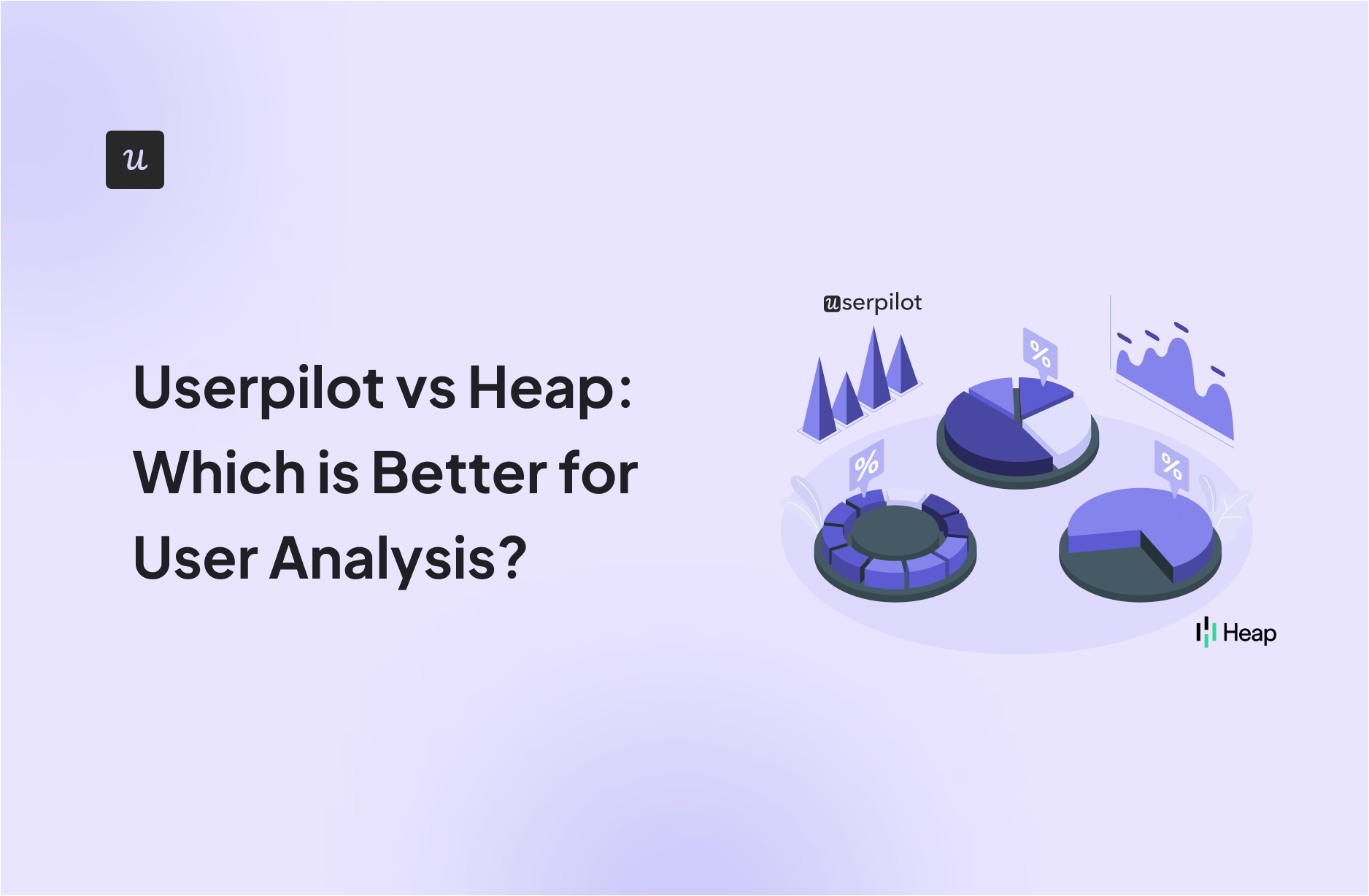
Is Userpilot or Heap the best tool for user analytics? And is there a better software that would better fit your needs?
With so many alternatives on review sites, it’s a bit tricky to choose one.
You need to consider your priorities and what functionality you’ll need from the tool to get the job done. Then there’s also the price that needs to match your budget. Right?
In this post, we’ll discuss exactly that – what the perfect tool for performing user analysis should deliver and which will be the best choice for your company’s needs.
Let’s dive in!
TL;DR
- Let’s explore how Userpilot and Heap compare when it comes to performing user analysis.
- Userpilot is a product growth platform that drives user activation, feature adoption, and expansion revenue. It also helps product teams collect user feedback, streamline onboarding, and gather actionable insights from analytics.
- Heap is a robust product analytics platform that provides users with a plethora of in-depth insights into customer behavior and needs. With Heap, you can track user interactions in real time across all touch points within your product.
- Heap offers a multitude of useful insights into product adoption and user behavior. But it has a few shortcomings and Userpilot rules in those areas. Here’s what makes Userpilot’s product analytics stand apart from Heap’s:
- Powerful segmentation capabilities: With Userpilot, you can segment users based on various factors, such as their feedback and interactions with tagged features and in-app experiences. This is in contrast to Heap, which limits segmentation to events and user properties (such as demographics).
- Intuitive UI: Userpilot packs relevant data and insights into a simple and user-friendly interface. That makes it suitable for users from non-technical backgrounds as well.
- Built-in engagement layer: Userpilot doesn’t just let you track user actions and behavior. It allows you to trigger personalized in-app surveys, product tours, and other experiences based on these insights. This, in turn, eliminates the need to use third-party customer engagement tools.
- Get a Userpilot demo and drive your product growth code-free.
What is user analysis?
User analytics is the process of capturing and analyzing user behavior within your product. This helps to understand how different segments act in-app, identify friction and drop-off points, and make data-driven decisions.
Must have features for user analytics tools
Choosing the right user analytics tool is important for understanding your customers’ behavior and optimizing their journey. Here’s what you should look for:
- Event tracking: The chosen tool should come with the ability to set up events for monitoring in-app behavior. It should be capable of tracking both client and server-side events so you can have a better understanding of how users interact with your product.
- Analytics dashboards: These include no-code reports and dashboards that you can easily build to draw meaningful insights from collected data. It’s also highly recommended that these dashboards have advanced segmentation filters so you can filter data for a better understanding of specific user groups.
- Surveys: In addition to behavioral data, it’s also necessary that the chosen tool is capable of collecting and analyzing feedback. Such direct data from customers can help you understand customer expectations and work on improving your product.
Userpilot for user analytics
User analytics lets you track and analyze the behavior of users within your product. Userpilot lets you filter through customers from a unified dashboard, extract insights from specific segments or time periods, and create custom segments for all users who meet certain conditions. Here’s an overview of Userpilot’s analytics features:
- Users dashboard: Userpilot’s users dashboard gives you an overview of all user data in one place. You’ll be able to filter by segments, which companies users are from, or when they were last seen active. You can also export data in bulk as a CSV or perform actions on individual users.
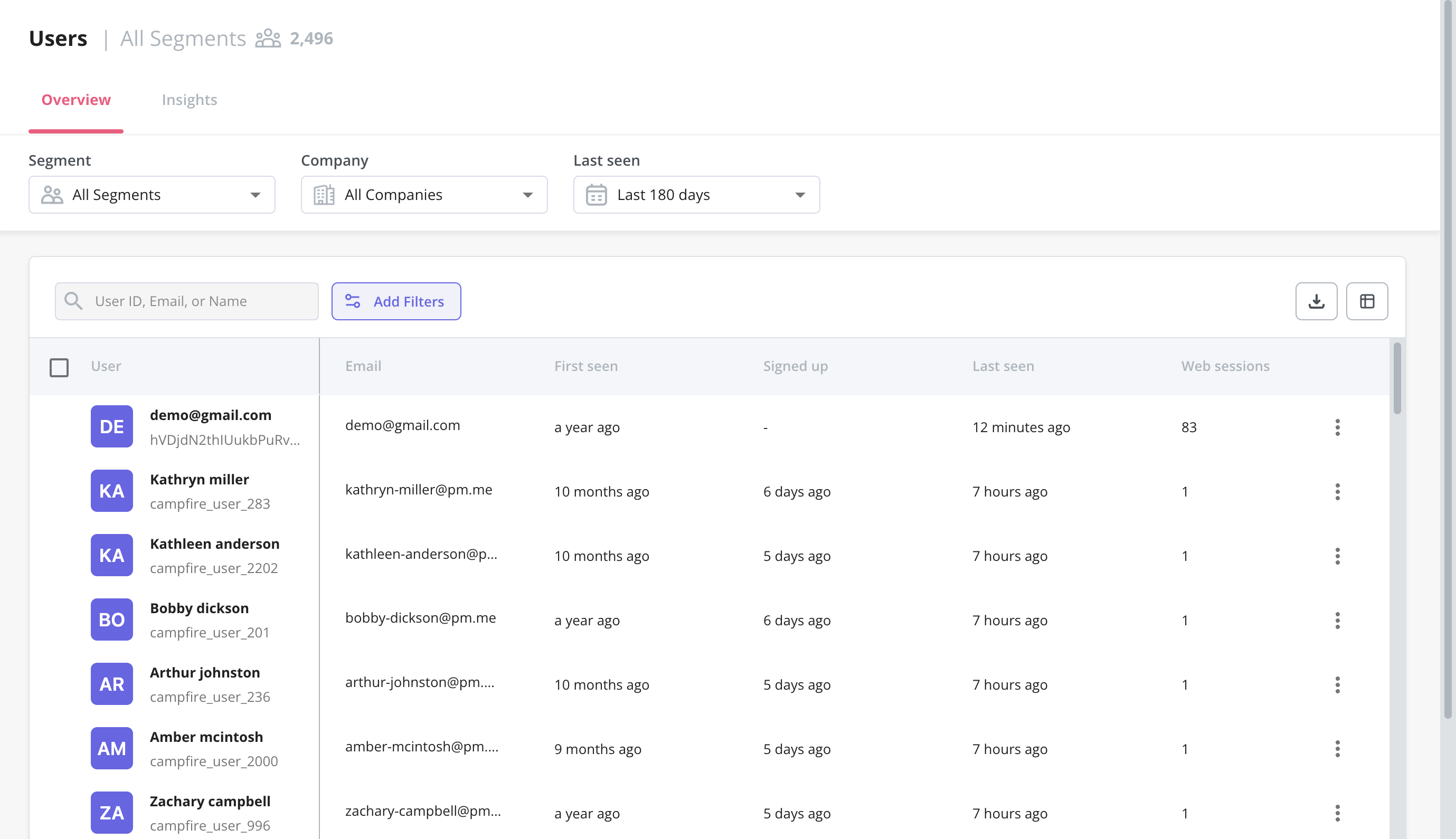
- User and company profiles: Here you can view data related to a certain user/company to gain insights into their behavior i.e. Top events, Top pages, Sessions, Sentiment – user’s feedback (NPS & Survey), etc. With such granular insights, you can go one step further with your personalization efforts.

User profile with top event data.
- Audience insights: Much like the overview dashboard, the Insights section lets you filter metrics by segment, company, and time period. You’ll be able to choose between a daily, weekly, or monthly view and then compare data between the current and previous time periods.
- Conditional segmentation: Practical use cases for user analytics include creating segments for all users that meet certain conditions. For instance, you could reach out to companies in a certain country when creating a new flow or target customers who have tried certain features.

- Saved reports: With Userpilot, you can create funnels, trends, retention tables, and path reports. The saved reports dashboard lets you view, edit, duplicate, or delete any trend and funnel reports you’ve created. You’ll also be able to sort by report type, filter by the teammate who created the report, or export in bulk if you need a CSV of your user analytics.
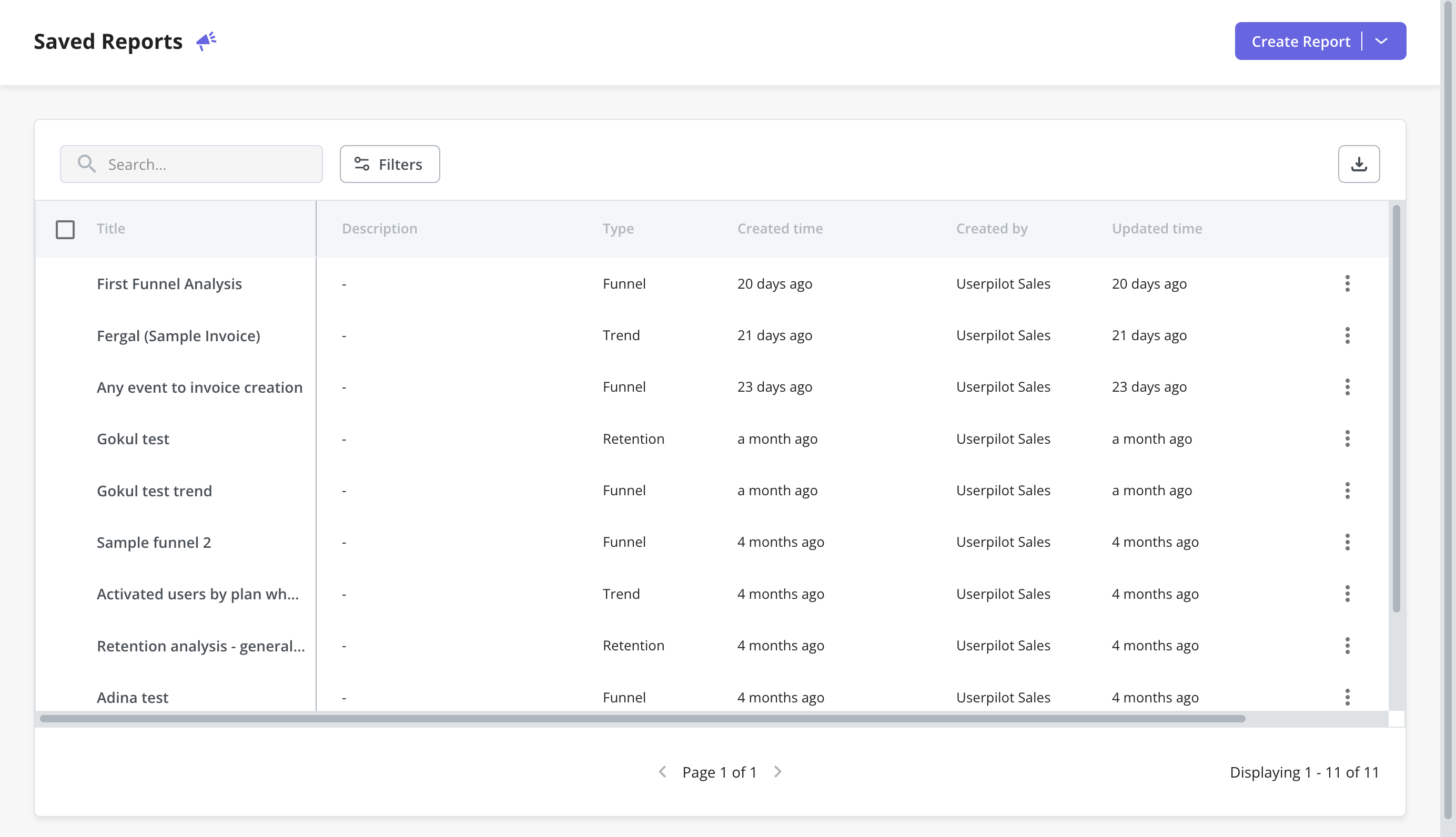
- Dashboards: Once you log in to Userpilot, you will see a collection of dashboards that collects all your key product metrics like product usage, user activation, feature engagement, etc. These dashboards are automatically available without you having to set anything up.
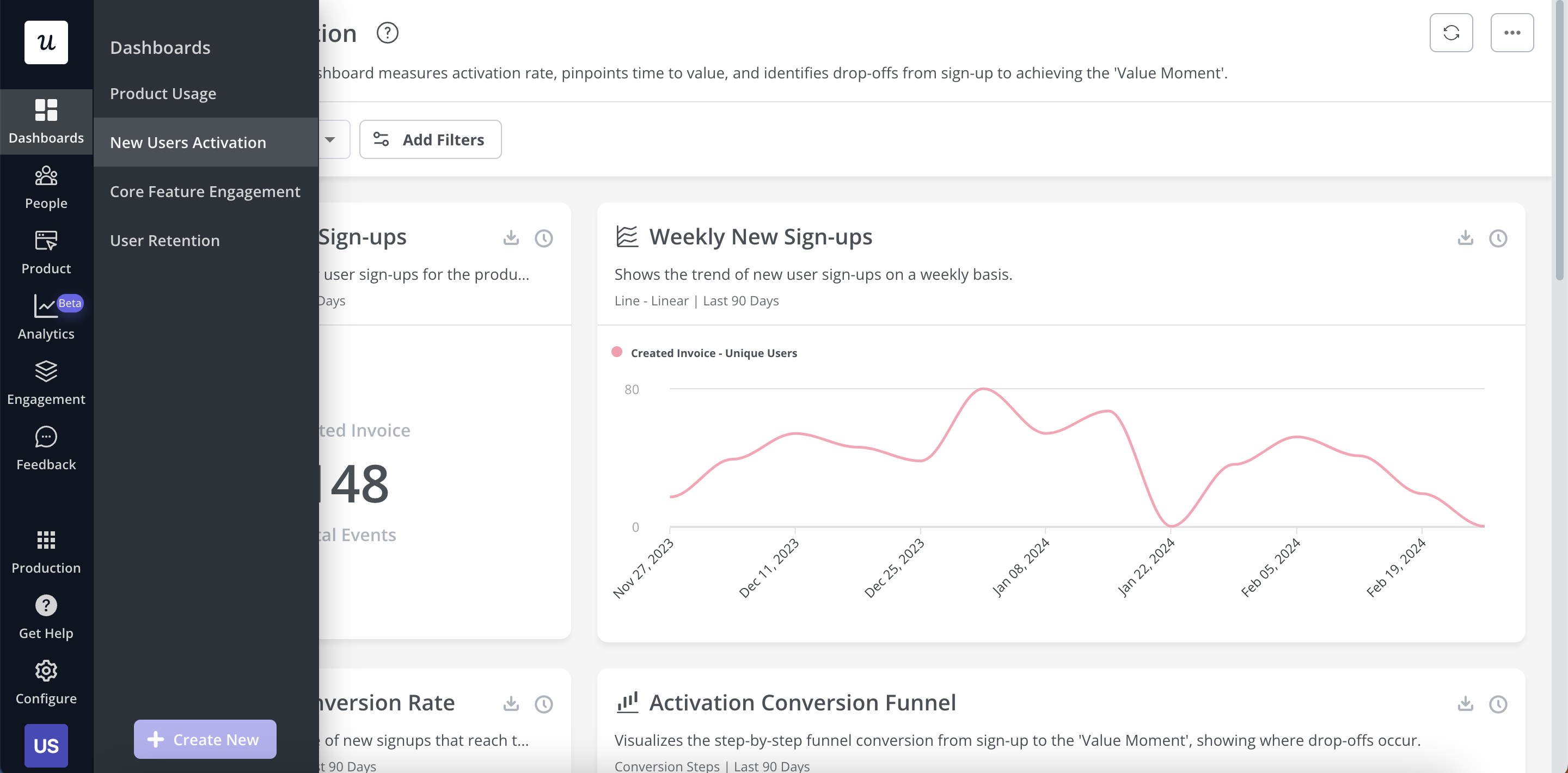
Types of analytics dashboards available in Userpilot currently.
In-app events in Userpilot
Tracking and analyzing event data gives you a better understanding of user behavior so you can capitalize on opportunities to improve the in-app experience.
Here are the ways you can use Userpilot as an event-tracking tool:
- Event tracking: The Userpilot flow builder lets you track custom events by tagging individual features (Feature Tag), by API (called Tracked Events) or by setting them up using a combination of feature tags and tracked events (Custom Events).

- Feature tags: Userpilot’s no-code feature tagger lets you track important features/elements based on different interaction types (clicks, hovers, and text inputs). You can then display the engagement and performance of different features through heatmaps.
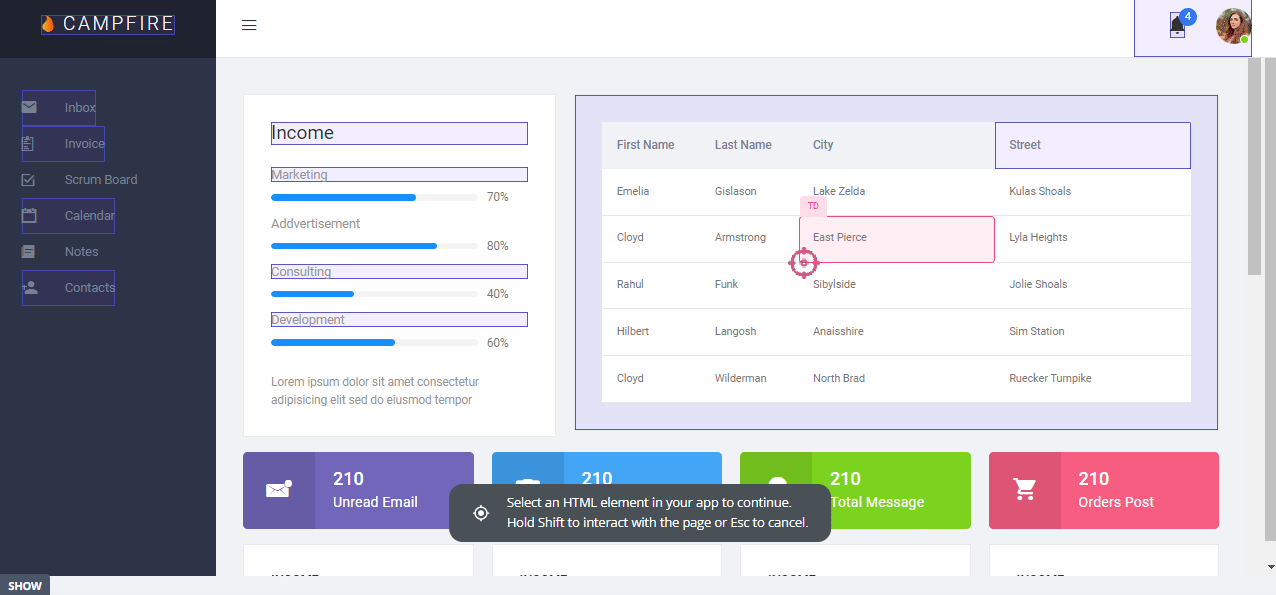
- Data integrations: Userpilot has native integrations with popular analytics tools like Amplitude, Mixpanel, Google Analytics, and more. This makes it possible to sync your event data across multiple tools within your tech stack.

In-app surveys in Userpilot
In-app surveys are an effective way to collect direct feedback from users without being at the whim of their email inboxes. Userpilot’s built-in functionality lets you create surveys, translate them, and track granular survey analytics that offer additional user insights.
Here are the Userpilot features you can use when building in-app surveys:
- Survey templates: Userpilot’s no-code survey builder has 14 templates to choose from. These include NPS, CSAT, and CES surveys among others for collecting quantitative and qualitative feedback from users. You can add a series of questions to gather valuable insights.

- Survey translation: Userpilot’s AI localization feature lets you translate surveys in a matter of minutes. All you need to do is add the desired locale and leave the rest to Userpilot. You can also make manual tweaks to translations if needed.
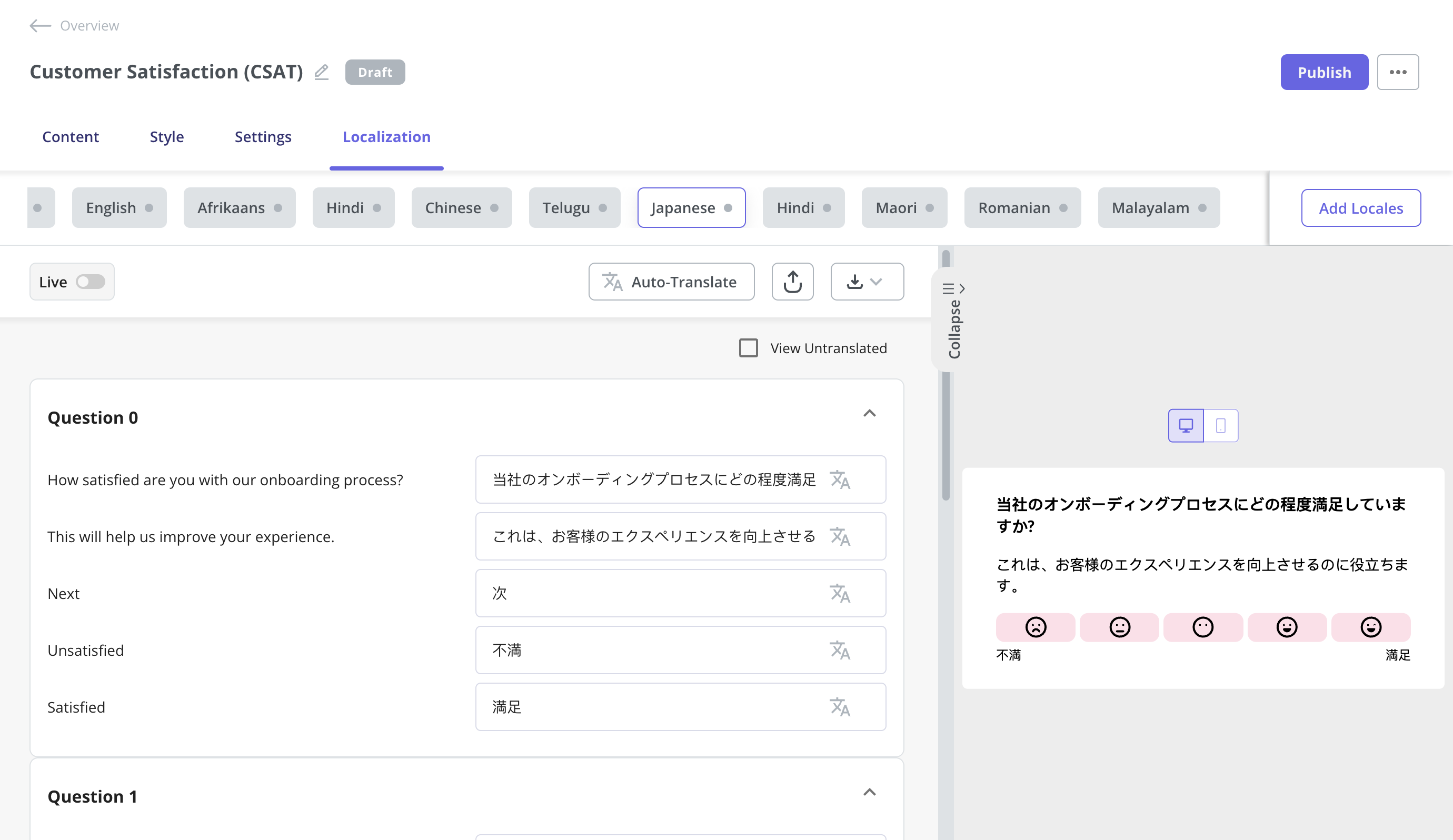
- Advanced analytics: Userpilot has detailed analytics that shows what percentage of users chose a specific option, summarizes the most popular choices, and lets you browse through open-ended responses to extract insights from qualitative feedback.

Heap for user analytics
Heap offers several features to help you track user actions, behavior, and properties. It lets you dig deeper into how users navigate your product and interact with different elements on a page.
The particularly useful features include:
- You can track various user sessions and filter the data based on date range and other parameters. It’s also possible to export the data into a .CSV file or Google Sheets.
Tracking user sessions on Heap.
- You can use a variety of heatmaps (Clickmaps, Scroll Depth, and Attention Maps) to understand user intent, identify points of friction, and improve UI.
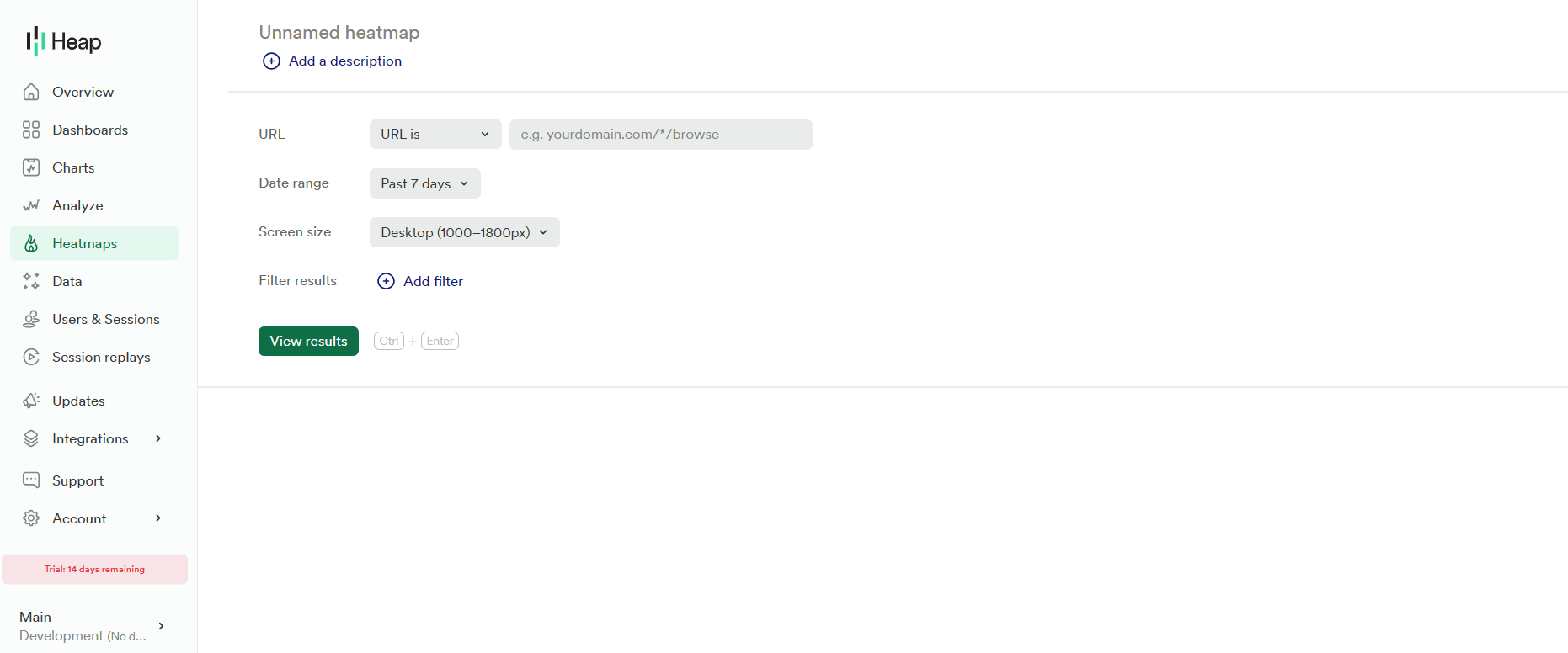
Heatmaps on Heap.
- The Session Replays feature lets you visualize the exact journey a user takes when performing an action.
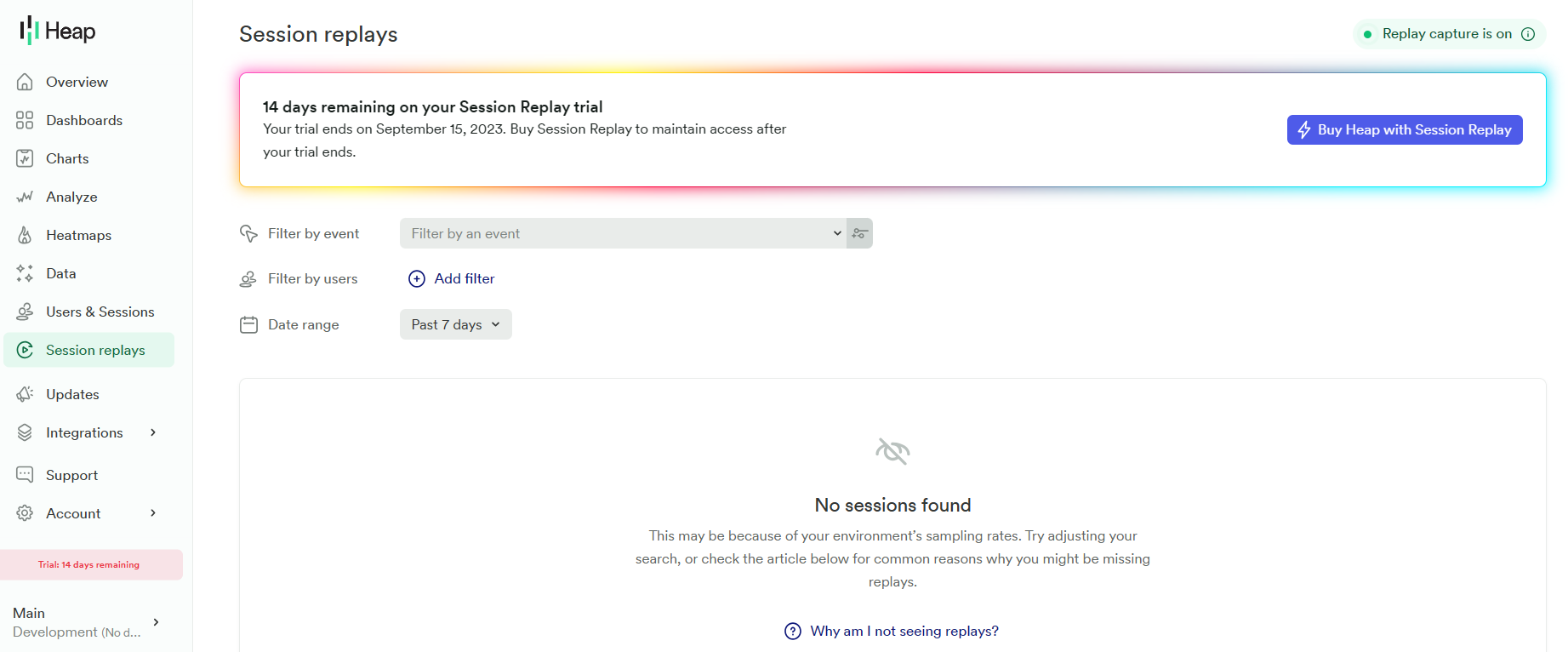
Session replays feature on Heap.
- You can use the Funnels, Journey Maps, Engagement, and Retention analysis features for a more detailed look at user behavior.
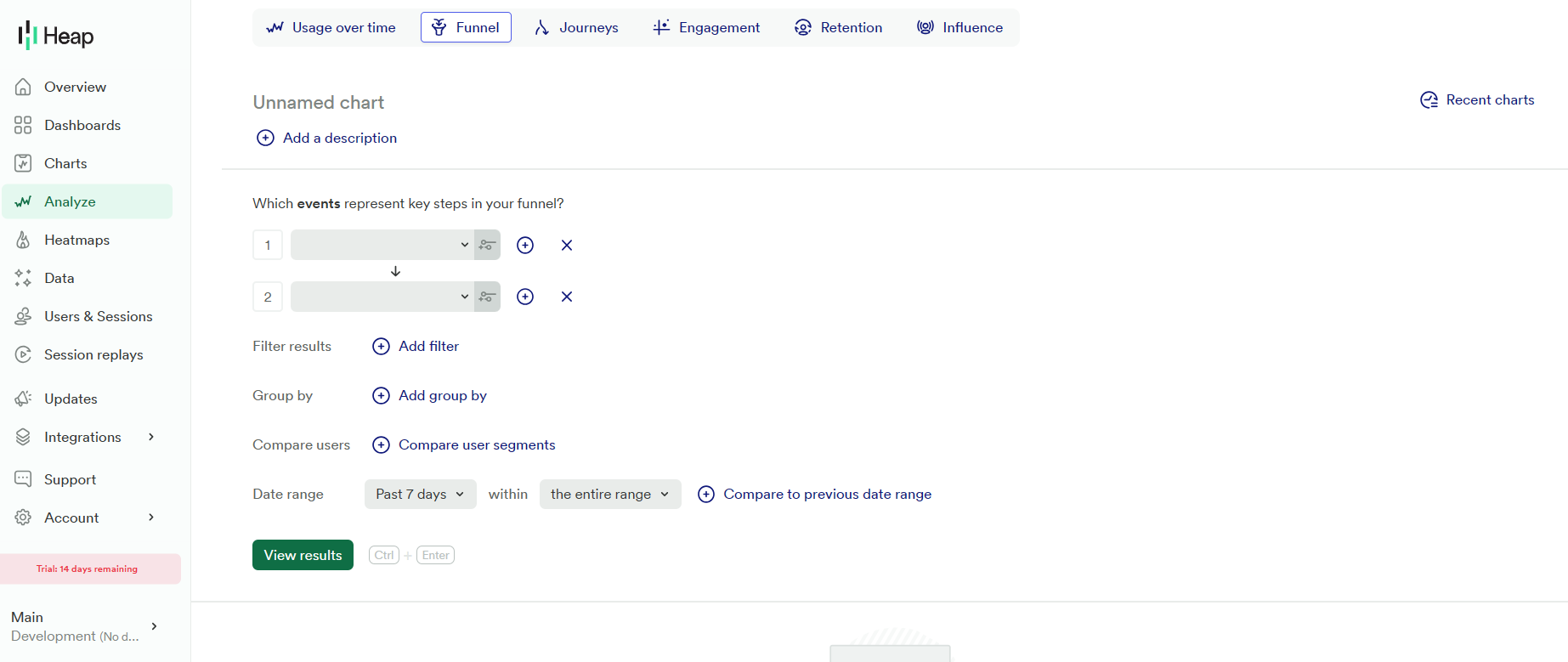
Analytics on Heap.
- You can segment users into different groups and filter all kinds of data for each segment. Loads of segment criteria are offered by Heap too.
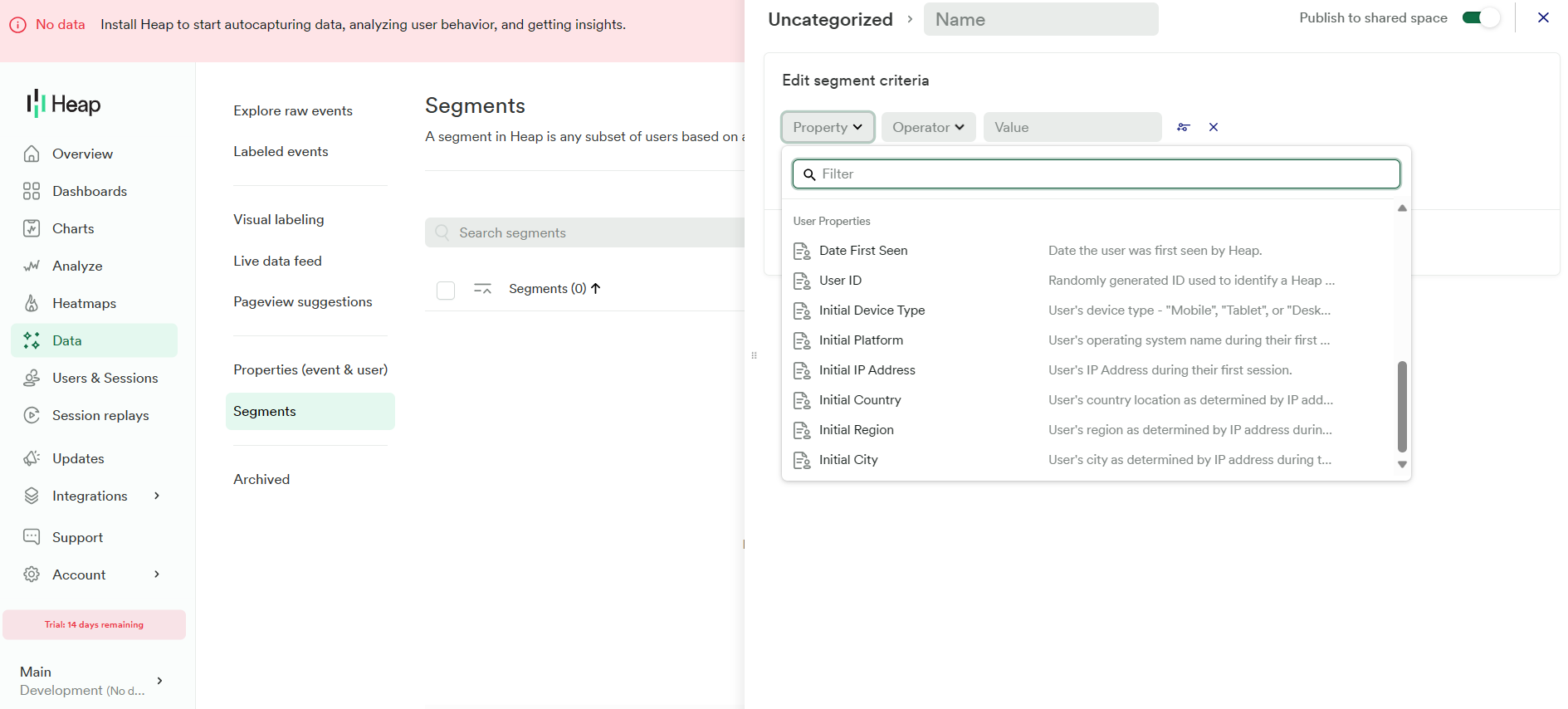
Segmenting on Heap.
- The Effort Analysis feature helps you quantify user friction and make immediate fixes to improve the user experience. It particularly helps with retention.
- The Pro and Premier plans also offer account-based analytics to help you monitor account health and churn. It’s particularly valuable for B2B companies and helps minimize churn.
In-app events in Heap
Event tracking is one of the most common use cases of product analytics tools. Measuring and monitoring event data lays the foundation for analyzing user behavior and improving the customer experience.
Heap facilitates event tracking in the following ways:
- The Auto Capture feature automatically tracks all user actions within your product. These include clicks, page views, form fills, etc. In other words, you don’t have to set up custom events.
- Under the Data tab of your Heap dashboard, you can access raw event data. It provides insight into common actions users take in your product.
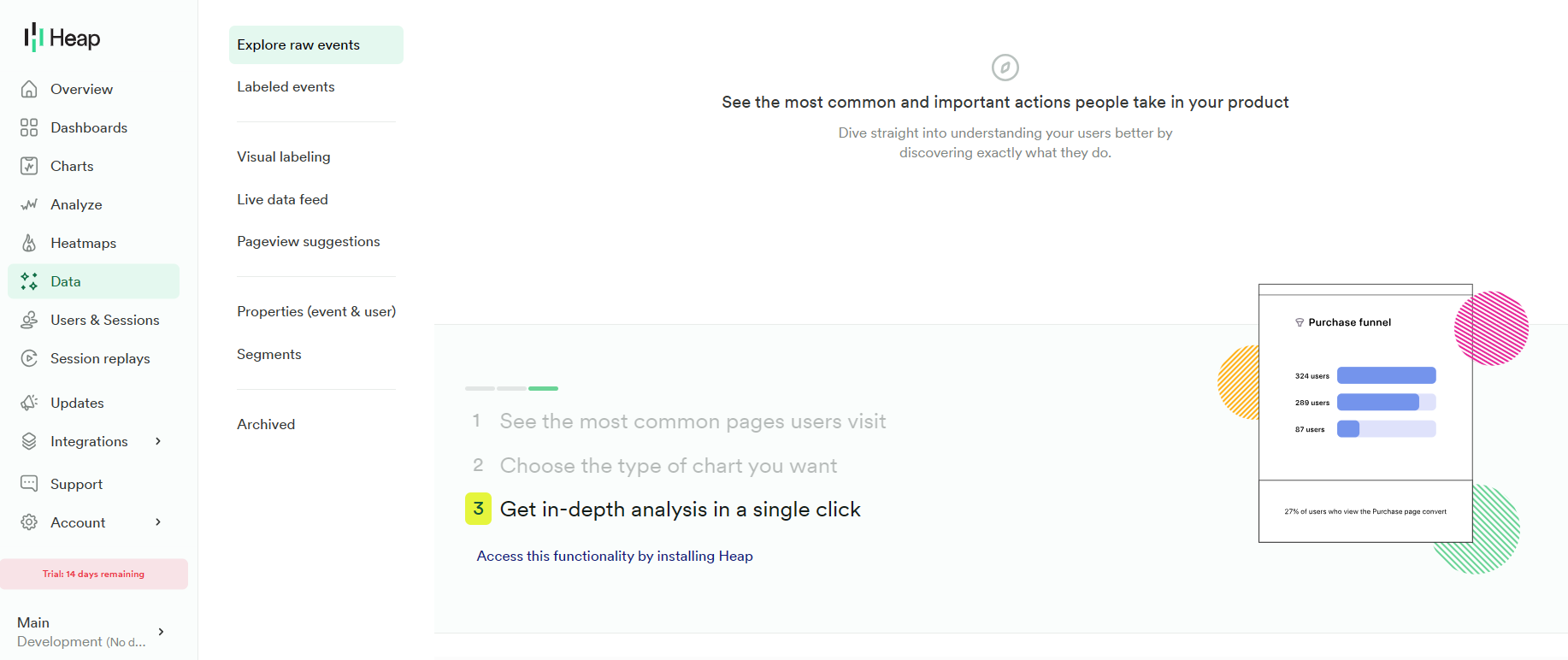
In-depth analysis on Heap.
- You can also identify the most important actions and assign meaningful labels to them. The events will be available in the Labeled events sections.
- The Live data feed ensures you can track and analyze the necessary events in real time.
- In the Properties section, you can find more relevant information about events and user interactions.
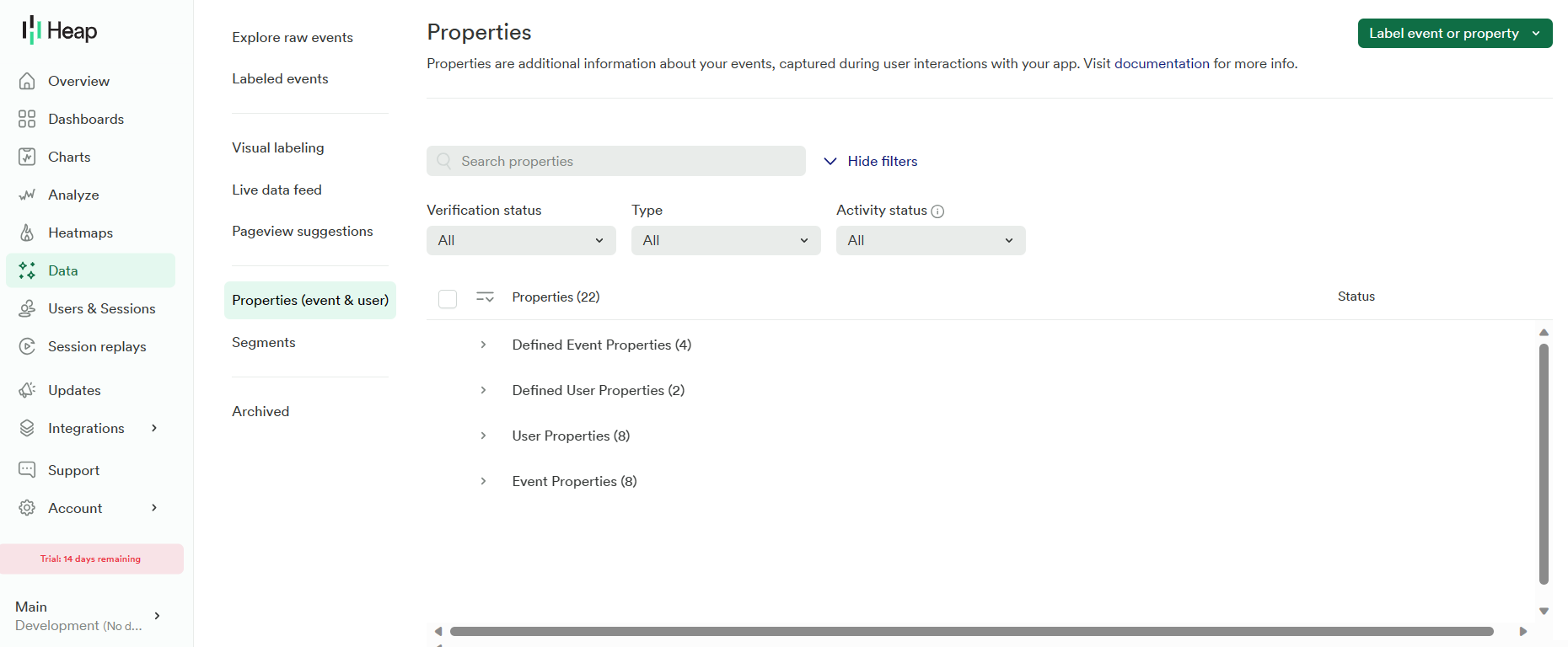
Properties section on Heap.
In-app surveys in Heap
Heap doesn’t support in-app surveys so you can’t collect direct customer feedback with it. Therefore, to collect in-app feedback, you’ll have to use third-party tools that integrate with Heap. Some tools in the list include Intercom, Chameleon, etc.
Pros and cons of Userpilot
While Userpilot’s versatile feature set and relatively affordable entry-level plan make it an attractive option for most SaaS companies, there are bound to be certain scenarios where it simply isn’t the right tool for the job.
Here are a few scenarios where you should look for a different tool other than Userpilot:
- Tight budgets: Userpilot is the best option for mid-market SaaS companies who want to get the most bang for their buck with plans including unlimited feature usage, fully interactive walkthroughs, advanced analytics, integrations, and a wide array of feedback collection mechanisms — all starting at $249/month. However, early-stage startups with sub-$100 budgets may want to look into options like Intercom, UserGuiding, and Product Fruits.
- Employee onboarding: Userpilot’s Chrome extension and no-code flow builder only works with your product, meaning it can’t be used to onboard employees to third-party apps. For onboarding internal teams, WalkMe is a viable solution that you should consider.
- Mobile apps: Userpilot is only compatible with responsive web apps as a narrow focus is essential to providing the best functionality needed to onboard users. As such, those looking to onboard users to mobile apps should check out platforms like Appcues and Pendo.
Pros of Userpilot
As a full-suite digital adoption platform, Userpilot has all the features you need to onboard users, track analytics, and gather feedback from customers without writing a single line of code. Here are a few pros of using Userpilot as your product growth solution:
- No-code builder: Userpilot’s Chrome extension lets you build flows, add UI elements, and tag features without writing a single line of code.
- UI patterns: There are plenty of UI patterns to choose from when using Userpilot, such as hotspots, tooltips, banners, slideouts, modals, and more!
- Startup-friendly: Userpilot’s entry-level plan gives you access to all available UI patterns so you can hit the ground running.
- Walkthroughs and flows: Build engaging interactive walkthroughs and personalized onboarding flows that target specific segments of your user base.
- Self-service support: Build an in-app resource center to help users solve problems, customize its appearance to align it with your brand, and insert various types of content (videos, flows, or chatbots) to keep your customers satisfied.
- A/B testing: Userpilot’s built-in A/B testing capabilities will help you split-test flows, iterate on the best-performing variants, and continually optimize based on user behavior.
- Feedback collection: Userpilot has built-in NPS surveys with its own unified analytics dashboard and response tagging to help you retarget users. There are other survey types to choose from and you can even create your own custom survey.
- Survey templates: There are 14 survey templates to choose from so you can gather feedback on specific features or run customer satisfaction benchmarking surveys like CSAT and CES.
- Advanced analytics: Userpilot lets you analyze product usage data, monitor engagement on all in-app flows, and use the data to create user segments that are based on behaviors instead of demographics.
- Event tracking: Userpilot’s no-code event tracking lets you tag UI interactions (hovers, clicks, or form fills) and group them into a custom event that reflects feature usage.
- Third-party integrations: Userpilot has built-in integrations with tools like Amplitude, Mixpanel, Kissmetrics, Segment, Heap, HubSpot, Intercom, Google Analytics, and Google Tag Manager so you can share data between all the solutions in your tech stack.
Cons of Userpilot
Of course, no tool is perfect and there are a few cons to consider before choosing Userpilot as your user onboarding or product growth solution:
- Employee onboarding: Currently, Userpilot only supports in-app customer onboarding.
- Mobile apps: Userpilot doesn’t have any mobile compatibility which could make it difficult for developers with cross-platform applications to create a consistent user experience for both versions of their product.
- Freemium plan: There’s no freemium Userpilot plan so those bootstrapping their startup and need sub-$100 solutions should consider more affordable onboarding platforms like UserGuiding or Product Fruits.
Pros and cons of Heap
Heap is one of the most sophisticated product analytics tools available in the market. But it isn’t without flaws.
Here are three scenarios where it makes sense to look for a Heap alternative:
- Your team lacks technical know-how: While it’s easy to install and configure Heap, navigating its features requires a bit of technical expertise. If your team members come from non-technical backgrounds, they might struggle to use Heap to the fullest.
- You want to trigger in-app experiences based on analytics: Heap doesn’t offer built-in tools to personalize the user experience based on product analytics and insights. You’ll need to use third-party engagement tools to turn these insights into actions. A product adoption platform like Userpilot can help you bypass the process of finding the right engagement tools.
- You’re on a budget: You need to set up a robust data storage infrastructure to retain all the data and insights collected from Heap. This is in addition to the monthly or annual subscription fee you’ll pay to use Heap. As a result, you’ll likely end up overshooting your budget, which makes Heap unsuitable for small teams and early-stage startups.
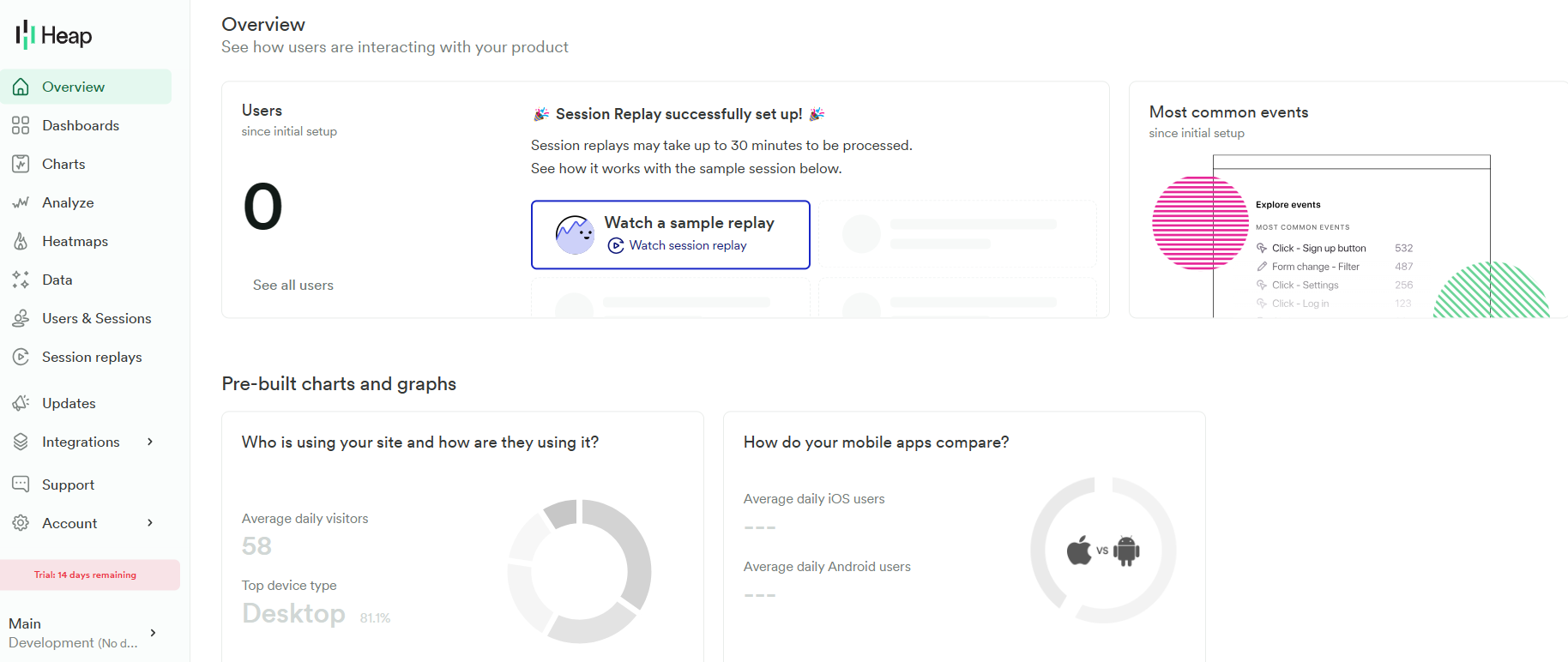
Pros of Heap
As a cutting-edge digital insights platform, Heap offers several valuable features for product developers, marketers, and customer success teams. Let’s take a closer look at its benefits.
- Automated data capture: Heap’s Autocapture feature lets you automatically track user actions, such as clicks, swipes, page views, and form submissions. That means you don’t have to worry about setting up custom tracking for each event. Also, you can track events retroactively.
- Easy setup: Getting started with Heap is as easy as installing a code snippet into your product. In other words, you don’t need a lot of technical knowledge or expertise.
- Advanced analytics: Besides Autocapture, Heap also lets you track custom events and services-side events to help you build a comprehensive user behavior data set. With features like Heatmaps and Session Replays, it results in unparalleled insights into how users navigate your product and the paths that lead to desired outcomes.
- Real-time insights: With the Live data feed, you get a chronological and real time view of all Heap events (raw and labeled). That means you can track and analyze user interactions as they happen.
- Seamless collaboration: Features like Shared Spaces facilitate collaboration and reporting among cross-functional teams. Similarly, you can share Session Replays with other team members.
- Web and mobile support: Heap works on all kinds of products, be it websites, web applications, or mobile apps.
- Extensive integrations: Heap supports integrations with more than 100 platforms, including customer engagement tools, data warehouses, product adoption tools, etc.
- Emphasis on customer education: Heap provides a variety of helpful resources to get you get started with the platform and use it to the fullest. These include Heap University (video tutorials), Heap Plays (how-to guides), Help Center, and a comprehensive blog and content library.
Cons of Heap
Heap comes with an impressive set of features that provide you with a 360-degree view of how users navigate your product and interact with various elements. But the product analytics platform isn’t without limitations.
Here are a few drawbacks of Heap worth mentioning:
- Steep learning curve: While the setup is a cakewalk, Heap involves a fairly steep learning curve due to its vast array of features. As a new user, it’ll take you a while to get a grip on all its features.
- Data storage requirements: Heap’s Autocapture feature requires you to collect and store a ton of data. Things can get expensive quickly as your product attracts new users.
- Lack of an engagement layer: While Heap offers an in-depth overview of user behavior and product usage, it doesn’t let you act on these insights. You’ll need other customer engagement tools to trigger targeted in-app experiences based on data and insights from Heap.
- Limited segmentation capabilities: Heap lets you segment users based on events and properties. It can be restrictive when you want to build hyper-personalized user journeys.
Userpilot vs Heap: Which one fits your budget?
Understanding the cost implications is paramount when selecting the right solution for user analysis, so here’s a detailed pricing comparison of Userpilot and Heap.
Pricing of Userpilot
Userpilot’s transparent pricing ranges from $249/month on the entry-level end to an Enterprise tier for larger companies.
Furthermore, Userpilot’s entry-level plan includes access to all UI patterns and should include everything that most mid-market SaaS businesses need to get started.

Userpilot has three paid plans to choose from:
- Starter: The entry-level Starter plan starts at $249/month and includes features like segmentation, product analytics, reporting, user engagement, NPS feedback, and customization.
- Growth: The Growth plan starts at $749/month and includes features like resource centers, advanced event-based triggers, unlimited feature tagging, AI-powered content localization, EU hosting options, and a dedicated customer success manager.
- Enterprise: The Enterprise plan uses custom pricing and includes all the features from Starter + Growth plus custom roles/permissions, access to premium integrations, priority support, custom contract, SLA, SAML SSO, activity logs, security audit, and compliance (SOC 2/GDPR).
Pricing of Heap
Pricing for Heap is available on request. You’ll have to contact the sales team for a quote. The final price will depend on various factors, including the number of sessions and integrations you need.
That said, Heap offers a free plan that lets you track up to 10,000 user sessions per month and stores your data for 6 months. Review platforms like G2 say that paid plans start at $3,600 per year. All paid plans come with a 14-day free trial, too.

You can choose from the following plans:
- Free: Ideal for teams looking to establish product-market fit.
- Starter: Suitable for startups looking to scale their business.
- Growth: Useful for companies that need advanced features, such as account analytics and report alerts.
- Pro: Tailored for enterprise businesses with robust security and compliance requirements.
It’s worth mentioning here that Heap offers a handy ROI calculator to help you get a clearer picture of whether it’s worth the investment.
Userpilot vs Heap – Why Userpilot might be a better choice?
Heap offers a multitude of useful insights into product adoption and user behavior. But it has a few shortcomings and Userpilot rules in those areas.
Here’s what makes Userpilot’s product analytics stand apart from Heap’s:
- Powerful segmentation capabilities: With Userpilot, you can segment users based on various factors, such as their feedback and interactions with tagged features and in-app experiences. This is in contrast to Heap, which limits segmentation to events and user properties (such as demographics).
- Intuitive UI: Userpilot packs relevant data and insights into a simple and user-friendly interface. That makes it suitable for users from non-technical backgrounds as well.
- Built-in engagement layer: Userpilot doesn’t just let you track user actions and behavior. It allows you to trigger personalized in-app surveys, product tours, and other experiences based on these insights. This, in turn, eliminates the need to use third-party customer engagement tools.
What do users say about Userpilot?
Most users laud Userpilot for its versatile feature set, ease of use, and responsive support team:
I recently had the pleasure of using Userpilot, and I must say it exceeded all my expectations. As a product manager, I’m always on the lookout for tools that can enhance user onboarding and improve overall user experience. Userpilot not only delivered on these fronts but also went above and beyond with its impressive new features, unparalleled ease of use, and truly exceptional customer support.
What truly sets Userpilot apart is its outstanding customer support. Throughout my journey with Userpilot, the support team has been responsive, knowledgeable, and genuinely dedicated to helping me succeed. Whenever I had a question or encountered an issue, their support team was always there to assist promptly, going above and beyond to ensure my concerns were addressed effectively.

Source: G2.
Of course, other users are also kind enough to share constructive criticism regarding specific features like event tracking filters:
“The filtration while analyzing specific events is a little confusing. Understanding of custom properties and data management configuration could have been more organised.”

Source: G2.
Conclusion
This is the end of our thorough comparison between Userpilot and Heap. You should be able to make a confident decision by now. If you’re looking for a solid tool for user analytics that promises great value for money, give Userpilot a go. Book a demo today.



